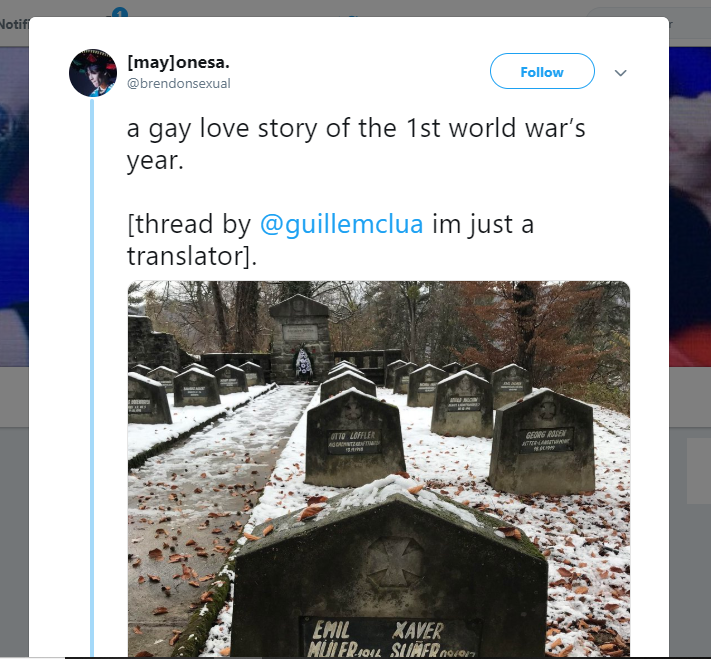“This is an amazing investigation – have you seen it @jackshoulder” a friend tweeted to me. Curious, and with a bit of time to spare, I delve headlong into the story of #EmilyXaver.
An intriguing shared tombstone, a gay love story for the First World War, the thrill of the investigator, @guillemclua, uncovering the tale step by step – what more could you want in a post? The thread is still online, and can be read, but Reader, it doesn’t end well.

The most devasting part?
It’s complete fiction.
In a Press Release by the author of the thread, he says:
“For me there is nothing more real than that emotion. Emil and Xaver existed, yes. But only in the story that all of us have shared loved each other with an intensity that we would all like to experience. With his story I have only wanted to shed light on all LGBT love stories that can never be told and that are condemned to oblivion.”
Wanting to shed a light on LGBTQ history is a noble aim. Indeed, there are people working in museums, galleries, universities and interested individuals not tied to any institutions doing just that.
Wanting to write an LGBTQ love story is also a good thing to do. LGBTQ people like reading too, and even non-LGBTQ folk can enjoy something well-written. Queer stories, and queer representations in fiction are important too. After the cinematic success of Call Me By Your Name, God’s Own Country and others, there’s a real thirst for it, too.
Writing an LGBTQ love story, but presenting it as history, with ‘documents’ to verify its existence is problematic. It’s damaging. It has ripples that will go well beyond a Twitter thread.
Like many others, I’m still reeling from the emotional whiplash from discovering everything written was lies. “But does that detract from everything?” asks Guillem, “I can not help but ask. Fiction saves us. I’m convinced of that.”
Yes, fiction can be a beacon in the darkness, but not when it casts a shadow over history or gives people the tools they need to further bury LGBTQ history.
Does this thread do that?
Yes it does. It takes an object, in this case, that evocative grave marker, and builds an LGBTQ narrative around it. A narrative that is needed, a narrative that has, on the face of it, been covered up and is crying out to be seen, to be shared. I’ve written before about What Makes an Object LGBTQ? and the answer is not as clear cut as it may seem.
R. B Parkinson, author of A Little Gay History, stresses the importance of academic rigour when presenting an object as being LGBTQ, or presenting an LGBTQ narrative to make the case for it airtight. This is well and good, but it means that we have to fight for our histories in the LGBTQ community. And fight hard. Tere are people doing wonderful work – see this from Stephen Bourne – and it goes without saying that the impact the V&A’s LGBTQ tours are having on the representation of LGBTQ objects and histories in museums is phenomenal.
But it’s not just academic rigour that needs to be adhered to – there is still a stigma that needs to be fought against. Working in heritage, I’m aware of some institutions struggle in working with LGBTQ figures from the past as their living relatives, or their estate refuse to have these figures publicly acknowledged as LGBTQ. I’ve heard those in charge of interpretation refusing to acknowledge any queer history due to ‘lack of evidence’ – even in the case of figures with well-documented same sex desires like James I.
More commonly LGBTQ relationships are obscured by euphemism; “companion”, “favourite”, “friend” when the relationship was so much more.
And this is when there is actual evidence. Tangible stuff. Words written in their very hand. An evidence of a life lived together.
Now with #EmilyXaver, evidence was created, fabricated, doctored. When reading the thread, this added to the authenticity of it, giving it a resounding ring of truth. The revelation of the falsehood has made it that much more difficult for real stories to come to light – #EmilyXaver has given homophobes another tool to bury LGBTQ history, making it all too easy for evidence to be dismissed – “it’ll be another fake.”
Yes, on reflection, the evidence in #EmilyXaver fell into place rather neatly, too neatly at times, which some smugly claim as how they could tell it was all codswallop.
Nothing in life, or death, is that easy. And hindsight is 20:20.
Personally, I feel angered by Guillem’s tactics in presenting his story this way. Why the need to hide the fiction? Because virality is easier to achieve with an emotional connection and a wow factor – something a series of spectacular real-life discoveries can achieve more easily than a fiction thread. Consequently, I, like many other people, feel emotionally exploited.
Professionally, Guillem has undermined the work, the hard work, that heritage professionals do to share LGBTQ histories.
Should we feel outraged? Yes. There’s plenty of evidence that points to this as a clever stunt to pitch a film, which leaves an even worse taste in my mouth.
What I am looking forward to as a result of this, is all the actual LGBTQ stories that academics, curators and historians will share. Maybe some good can come of this?